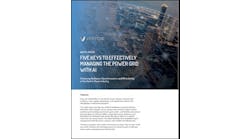The Environmental Defense Fund’s Kate Zerrenner describes the water-energy nexus impacting Cape Town as it runs dry, and posits that parts of the U.S. could face the same threat.
Kate Zerrenner, EDF senior manager, energy-water intiatives
In Cape Town, South Africa, the countdown is on for Day Zero when water taps in the city of 4 million people are expected to run dry.
Yet, while this water crisis has been making headlines worldwide, nobody’s talking about the connection between water and energy. In a rapidly changing climate, we should.
Cape Town may be the first major city staring down a water scarcity crisis, but it’s not alone. One-quarter of the world’s large cities, including at least two in the United States, are “water-stressed,” a 2014 study found.
As it turns out, many of them also happen to rely on the world’s thirstiest energy source: coal.
23,000 gallons of water a month to power a single home
In the symbiotic relationship known as the energy-water nexus, we use power to treat and distribute water, while water is used to process and deliver power. This is why our energy choices directly affect our water resources – and lack thereof.
Traditional power resources such as coal, natural gas and nuclear fission require on average 25 gallons of water to produce one kilowatt-hour of electricity. Coal plants top the list; they withdraw between 20 and 60 gallons of water per kilowatt-hour, depending on the plant’s cooling technology.
A typical American home uses about 900 kWh per month, which translates into nearly 23,000 gallons of water per household per month – just for electricity.
Which brings us back to Cape Town: 92 percent of South Africa’s power comes from coal. So while residents may be taking shorter showers and doing their best to conserve water, the country’s power plants are gulping it down.
Is Miami next?
Cape Town is in uncharted water territory and with climate change rapidly altering temperatures and weather patterns, U.S. cities probably aren’t far behind.
Climate predictions show an increasingly hot and dry America and the evidence is all too visible.
Only six months after Hurricane Harvey, Texas is back in drought. California could be living through more than a decade of drought, which has already upended the state’s agricultural industry.
And the water stress is spreading eastward. New England and the Southeast recently suffered unprecedented droughts – and Miami is now expected to be the first U.S. city to run dry.
This trend tells us that now’s the time to have a closer look at the energy-water nexus, and how to make the best use of what water we’ve got left.
These power sources use almost no water
The upside of all this is that we have a powerful water conservation tool with multiple co-benefits at our disposal: clean energy. Solar photovoltaics and wind power use virtually no water. Energy efficiency uses none.
To this day, 85 percent of U.S. electricity comes from our thirstiest energy resources, fossil fuel and nuclear power plants. Expanding the use of renewable energy and energy efficiency, while weaning ourselves off the thirstiest power sources, will lead to huge water savings at the right time.
This is our opportunity here and around the world as we plan for the reliability and resilience of our energy and water systems. It’s no longer possible to ignore the impact our energy sources has on critical water supplies, and vice versa.
We have already begun to turn toward a cleaner energy economy. The question now is whether we can ramp things up before the next big city goes dry.
Kate Zerrenner is a senior manager for EDF’s energy-water initiatives. This blog originated on EDF’s blog and was reposted with permission.







